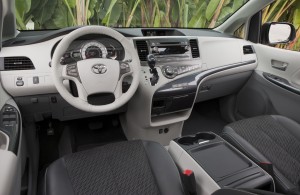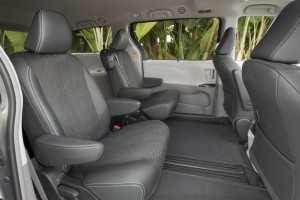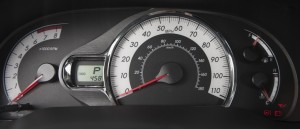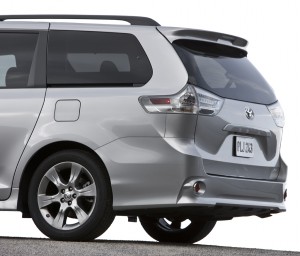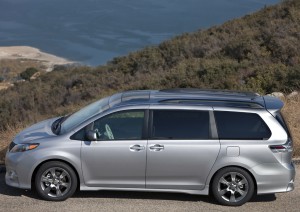
The 2011 Toyota Sienna SE has a sporty vibe. Will it encourage would-be crossover shoppers to consider a minivan?
Maybe they’ve gone too far, this time. In the never-ending attempt to make the minivan cool, Toyota has taken the Sienna over the top.
At least it doesn’t look like a minivan trying to look like an SUV. Nope, this box is minivan through and through. But hung on that box are all sorts of air dams, spoilers, creases and shapes. The result is a minivan that looks like it had a makeover by one of those TV vehicle makeover shows.
To be fair, this is the SE – sport edition in Toyota nomenclature. It’s meant to be sportier and edgier. For those buyers who can’t see themselves driving this hipstermobile, Toyota offers three other trim levels – base, LE and XLE – which have less razz matazz.
At least Toyota is making an effort. Minivan sales have lagged for years while buyers opt for sexier SUVs and crossovers. But for most buyers, minivans would actually make the most sense because they offer more space, cost less, handle better and some get better fuel mileage.
SE or not, Toyota has given the new Sienna added visual interest with arcing creases, a shapely grille and bigger wheels.
For the core group of minivan buyers, exterior styling hardly matters. They care about what’s inside. On that front, Toyota made some interesting choices, some good, some not so good. More in a moment.
The Sienna starts at $25,270 with the standard 2.7-liter four cylinder. The cheapest Sienna with the optional 3.5-liter V-6 is $26,570. With a boatload of options bring the as-price to $35,849. Power goes through a standard six-speed automatic to the front wheels (standard) or all four.
First the good. By pushing the windshield farther forward, the Sienna gained interior space, meaning it has expansive room for all passenger and makes an even better moving van for taking junior to college. Like most Toyotas, the stereo and heating/ventilation controls labels are big enough to read from the back of the van. The speedometer has the clearest markings of any vehicle in memory. The seats are long-haul comfortable. The 60/40 split third-row seats are easier to fold than the old van.
Now for the bad. Unlike many other minivans, the center stack is relatively flat, meaning some of the controls for the radio and HVAC are difficult to reach. The color of the grey door panels don’t match the dashboard. Speaking of the door panels, they no longer provide an inviting elbow rest.
The tiny dashboard screen, which displays the backup camera image and HVAC settings, at the top of the stack is too far away. Also, the screen doesn’t dim with the rest of the instrument panel lights, so there is always a bright light shining, making concentration on dark freeways somewhat more difficult.
And what’s the deal with no compass?
Toyota decided against Dodge Grand Caravan-style disappearing middle-row seats and the bucket that doubles as a storage bin. In fact, the Sienna abandons the excellent flip-and-fold seats of the previous generation for seats that move on tracks, similar to the Honda Odyssey. It seems like a strange choice because the new seats take up more room when folded, meaning less cargo space and they’re no longer removable. Both Honda and Toyota have ceded the minivan-turned-moving-van market to the Dodge and its twin, the Chrysler Town & Country.
While the middle-row seats may not get out of the way as well as the Dodge, they are comfortable when they’re in place. Unfortunately, Toyota reduced what was a fairly comfortable seat in the middle of the second row and replaced it with a narrow, thinly padded one that is inhabitable by children only. The center seat folds to serve as an armrest, but it doesn’t include any cupholders. There are cupholders underneat the center seat, which can be removed and stowed in a storage area in the back of the van.
The third-row seat is comfortable, too. While the cushion is somewhat low, there’s plenty of leg and headroom.
 The Sienna’s optional 266-horsepower, 3.5-liter V-6 carries over, but it didn’t need much work. It provides a useful kick, making passing on two-lane roads a snap. While both the Sienna and Odyssey are rated at 19 mpg city, the Honda wins on the freeway with 28 mpg, compared to the Sienna’s 25. We saw 22 in mostly freeway driving. But the Honda gives up 18 horsepower to the Toyota.
The Sienna’s optional 266-horsepower, 3.5-liter V-6 carries over, but it didn’t need much work. It provides a useful kick, making passing on two-lane roads a snap. While both the Sienna and Odyssey are rated at 19 mpg city, the Honda wins on the freeway with 28 mpg, compared to the Sienna’s 25. We saw 22 in mostly freeway driving. But the Honda gives up 18 horsepower to the Toyota.
And here’s a shocker: The four cylinder carries the exact same mileage ratings as the six, even though it has 79 fewer horsepower. What was the point of offering a smaller engine if fuel mileage isn’t any better? The V-6 adds $1,240 to the bottom line.
The six-speed automatic transmission operates unobtrusively, always coming up with the right gear for the right situation.
The Sienna comes standard with front-wheel drive, but all-wheel drive is still an option. In fact, now that Chrysler no longer offers AWD versions of its vans, the Sienna is the only minivan available with that option.
The Sienna’s handling is minivan typical. It tracks well on the freeway, has decent steering feedback and the ride is smooth. Most minivan buyers won’t expect anything more.
There’s no getting around the fact that a minivan is a big box, but Toyota has tried to make it as visually appealing as possible. We’ll see if it leads to any more sales to folks who may be considering a sexy new crossover instead.

